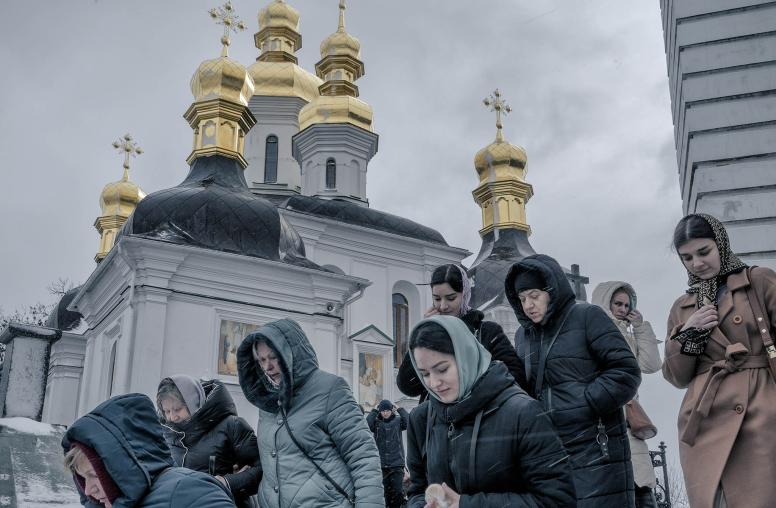Despite Moscow’s Brinkmanship, U.S. and Russia Explore Deeper Relations
The Biden administration aims to advance priorities like strategic stability, while keeping a close eye on Russia’s actions.
Although at odds on a host of key geostrategic issues, Washington and Moscow have this year quietly sought to stabilize the tension-laden bilateral relationship. A June summit between Presidents Biden and Putin in Geneva has been followed by several high-level engagements in recent months between U.S. and Russian officials, including CIA Director William Burns’ early November trip to Moscow. For the Biden administration, this engagement allows it to explore areas of accord while closely watching Moscow and its efforts to undermine U.S. interests. For Putin, the talks demonstrate that Russia is the global power he claims it is.

USIP’s Donald Jensen looks at what these talks are focusing on, how Washington can balance competition and cooperation with Moscow and how Russia’s aggressive actions toward Ukraine impact the U.S.-Russia relationship.
This is at least the fourth time a senior U.S. official has visited Moscow since July. What’s driving the Biden administration’s shift toward more direct engagement with Russia?
CIA Director Burns visited Moscow on November 2-3 to push back against recent Russian bad behavior, including its military buildup in Ukraine, renewed cyber activity against the United States and willingness to reduce energy supplies to global markets as winter approaches. In addition to a telephone call with President Putin, Burns met face-to-face with Nikolay Patrushev, secretary of Russia’s National Security Council, and Sergey Naryshkin, head of the Foreign Intelligence Service (SVR). The United States reacted strongly when the Kremlin built up forces along the Ukrainian border last spring — President Biden complained to Putin about Russian aggression in Ukraine at their summit in Geneva in June, with some success. The Burns visit as well as last month’s by Victoria Nuland, undersecretary of state for political affairs, may lead the Kremlin to act with restraint again.
What issues are these talks focusing on?
During their summit in June, President Biden said he expects Russia’s policies to be “stable and predictable.” So far, regular contacts are focused on military-to-military conversations, including a September meeting between the two countries’ senior defense officials. But regular diplomatic contacts are at a standstill. The two countries have had “constructive” talks on strategic stability, but those have been complicated by the projected growth in China’s nuclear forces, which are one factor undermining the established arms control architecture inherited from the Cold War. The rise of China, Russia’s frequent partner, also weakens the latter’s claim to be the only strategic counterpart to the United States. Terrorism and climate change may be issues for a future agenda. However, Putin’s absence from the COP26 environmental summit in Glasgow shows Moscow’s lack of commitment to reducing greenhouse gas emissions.
It is crucial to keep in mind that Russia defines these problems very differently from the United States. The Kremlin’s way of diplomacy is sometimes at variance with ours — it is a product of a very different strategic culture that sees Russia as surrounded by threats, especially from the West, capable of undermining the regime. Moscow uses deception as an everyday instrument of foreign policy and violates international norms when it serves its interests. These differences can make agreements between the United States and Russia difficult and result in implementation problems down the road.
What are we to make of the juxtaposition of both governments’ more public, adversarial approach and these high-level meetings between officials? How can the United States balance competition with Russia while maintaining cooperation in areas of mutual interest?
The governments’ public, adversarial approach reflects deep differences on vital issues and may be designed to reassure domestic constituencies, some of which may be wary of getting too close to the other side. Trust between the two countries is low. My impression, however, is that in Russia especially, the media has heavily covered these meetings — in part because the appearance of Washington dealing with the Kremlin as an equal signals that that Russia is the great power Putin claims it to be.
More importantly, the operative understanding seems to be, as you say, that the two sides will seek accord on issues where their interests converge and agree to disagree when they do not. This is much more difficult than it seems at first glance. Bureaucratic politics drive it on both sides, as well as the factors I mentioned earlier. It is essential that the Biden administration make clear what is on and off the table since Moscow will likely probe U.S. positions for weaknesses it can exploit, and may practice “linkage” by making progress on an issue of “mutual concern” contingent on agreement on issues where there are major differences, such over Ukraine.
Burns’ trip came as reports surfaced that Russia was building up its military presence on the border with Ukraine. What’s behind the buildup, and how does the situation in Ukraine affect efforts to stabilize the U.S.-Russia relationship?
I share CIA Director Burns’ concern about Russia’s irregular movement of troops near Ukraine’s northern border and was pleased he telephoned Kyiv last week to assure Ukrainian President Zelensky of U.S. support. The movements are especially worrisome because they came after Vladimir Putin’s long article last summer arguing that Ukrainians and Russians were one people and former Russian President Dmitry Medvedev’s aggressive comments in the newspaper Kommersant that Ukraine is not a sovereign state and under “external governance” by the United States and European Union.
Russia has used the threat of military action, as an essential part of its long campaign to intimidate and destabilize Ukraine since the 2014 Maidan crisis. It could increase its military involvement now or be using the movements to keep Ukraine and its partners off balance. For this reason, it is important that the Biden administration keep up the pressure on the Kremlin to halt its aggression.



